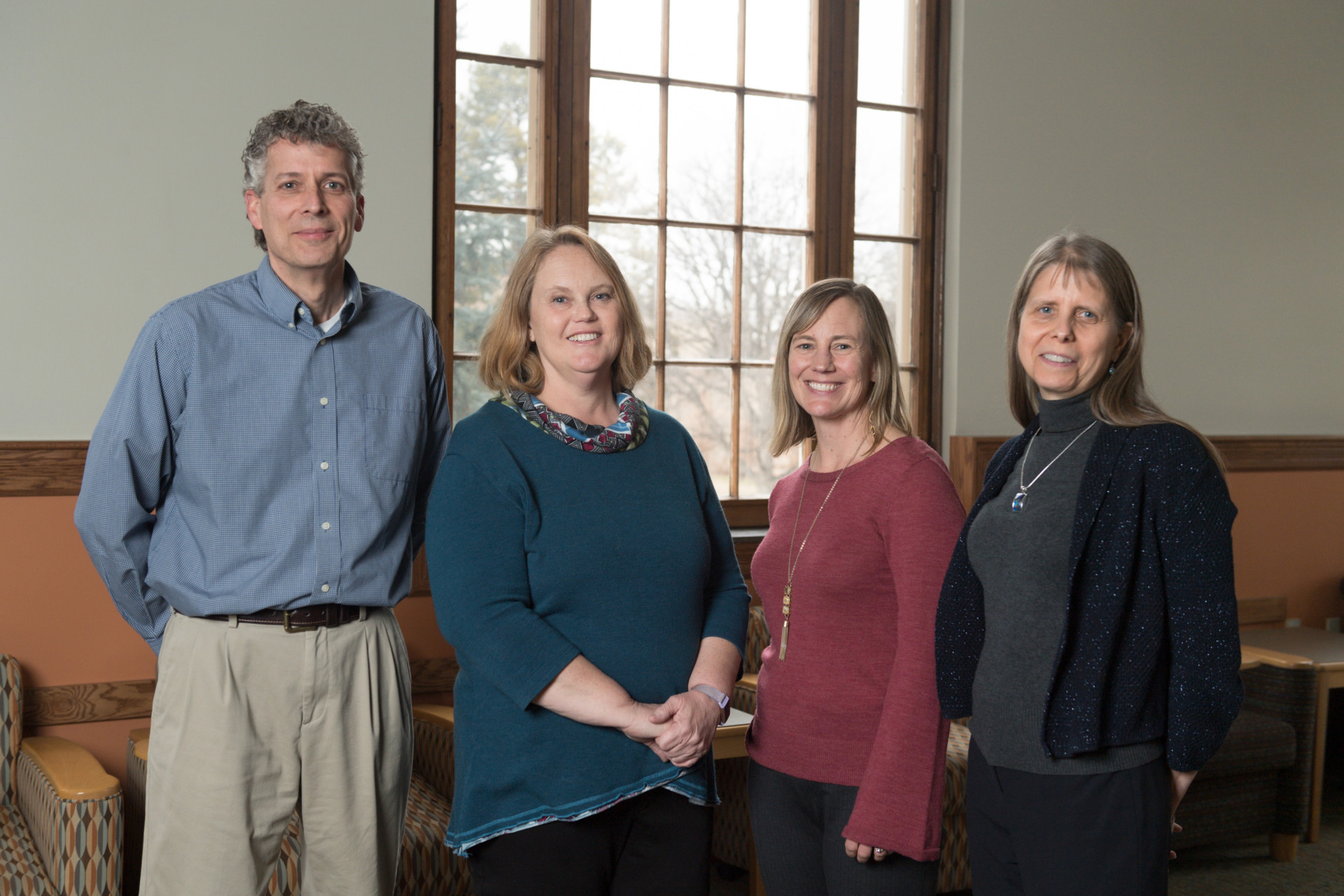
Stan Kruse, Tonya Buchan, Jennifer Todd and Gwen Gorzelsky in the Great Hall of the TILT Building. Photo by William A. Cotton, CSU Photography
Tonya Buchan, Stan Kruse and Jennifer Todd, instructional designers with The Institute for Teaching and Learning at Colorado State University, will present their work on adaptive courseware at the upcoming national conference of the Online Learning Consortium.
The project, which was undertaken with a three-year, $515,000 grant from the Personalized Learning Consortium (PLC) of the Association of Public and Land-grant Universities in 2016, has studied whether the use of personalized adaptive courseware positively impacts student success and retention. It was selected as the best project on the Research: Designs, Methods and Findings track of the OLC Innovate 2020 virtual conference, set for June 15-26, which is devoted to building bridges in digital, blended and online learning.
Adaptive courseware provides students with individualized instruction and feedback to help them master basic and foundational concepts. The implementation of the grant was designed to explore new and innovative ways to support students with high-impact practices while they use the adaptive courseware.
Buchan, who is also the manager on the APLU grant, explained that the team has been working with instructors at CSU to gather data on how different approaches can improve learning outcomes for students in high-enrollment courses, especially those with a high percentage of Ds, Fs, and Ws (withdrawals). The goal is to make the most promising findings and practices identified by the grantees available to the APLU’s more than 200 members nationwide.
Each of the eight universities involved in the grant explored different platforms for delivering the courseware – some have used products provided by textbook publishers, some used existing courseware that is independent of specific textbooks, others have built their own customized tools – to support material available from 20 approved vendors.
“We’ve been working together, but recognize that there are different needs at different schools,” Buchan said. “We want to find what makes most sense for each institution.”
Algorithms guide outcomes
Kruse said the heart of any adaptive courseware is an algorithm that responds to how students answer questions and presents different tasks to help them progress based on those answers.
“Outcomes at each level build on what was mastered at the previous level,” he said, adding that this approach shares aspects found in most popular video games. Help in mastering the levels is built in and can come in a variety of forms.
Todd added that students are presented quizzes at various stages of the program, and depending on their answers, they might get a hint, or a link to specific text to learn more about the difficult topic. “It’s a point-based system – you can earn or lose points – but you can always stop and go back,” she said. “The idea is to build students’ confidence levels.”
Buchan said that the courseware has been used in 70 different classes across several disciplines at CSU so far, with varying enrollments up to 350 and several teams of instructors.
“It was exciting to see the instructors working together and learning from each other to share the development of the courses,” she said.
The instructors also met two or three times each semester to share experiences and integration of the courseware. These meetings were led by TILT instructional designers and covered topics such as classroom climate, instructional strategies, and feedback and assessment – all components of an active learning classroom.
Data collected
The researchers collected data on student perceptions of the courseware for three semesters and faculty perceptions for two and have correlated those with student success data from Institutional Research, Planning and Effectiveness. Final figures from IRPE will be available in the summer, allowing the team to look at the outcomes from all three angles and incorporate what works best into ongoing course redesigns.
During their work with faculty, they followed the principles of backwards design and aligned the adaptive courseware and research-based teaching practices with course learning outcomes, Todd said.
“Adaptive courseware is a tool that, to be effective, must be used well,” she added.
Although the original grant ended last semester, additional funding to continue gathering data through this semester was approved by the PLC.
“We have had great support for this project from the Provost’s Office as we develop research-based practices to integrate into the classroom for increased student success,” Buchan said. “This will really help us figure out where to spend our time.”